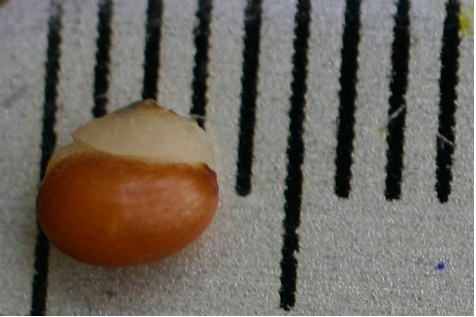From flower to seed and back again
The Trillium is an angiosperm and is monoecious. This means it produces true fruit and has both sexes on the same plant. To understand Trillium reproduction one must first learn the reproductive parts of the flower.
 The male reproductive parts are called stamens. They
consist of the filament and anther. The filament is the stalk
that holds up the anther. The anther contains pollen sacs that
produce pollen.
The male reproductive parts are called stamens. They
consist of the filament and anther. The filament is the stalk
that holds up the anther. The anther contains pollen sacs that
produce pollen.
The female reproductive parts are called carpals which consist of a stigma, style and ovary. The stigma is structure that accepts pollen. The pollen then travels down the neck like style to the the ovary.
Pollen grains, which contain the male gametophyte (sperm), are carried from the anther to the stigma of the same or, preferably, a different plant. They are usually carried by insects and more often than not the insect will be a bee. A different plant is preferable because it increases genetic variation and can be advantageous in changing environments, allowing the plant to adapt instead of dieing out.
 After the pollen grain lands on the stigma it travels down a
pollen tube to the female gametophyte (egg) located in the ovary.
The sperm and egg fuse to form a zygote. After a zygote is
formed the ovule develops into the seed and the ovary forms a
protective fruit around the seeds.
After the pollen grain lands on the stigma it travels down a
pollen tube to the female gametophyte (egg) located in the ovary.
The sperm and egg fuse to form a zygote. After a zygote is
formed the ovule develops into the seed and the ovary forms a
protective fruit around the seeds.
The fruit develops over a six to eight week period. It has six angles, no odor, and a mealy inside. It is one-half to one inch wide and white to pale green in color.
 As
the fruit ripens, inside of it develop many one-eighth inch brown
seeds. As the seeds grow they weigh down the stalk, bringing
it closer to the ground.
As
the fruit ripens, inside of it develop many one-eighth inch brown
seeds. As the seeds grow they weigh down the stalk, bringing
it closer to the ground.
The seeds also put pressure on the capsule until it breaks open, and the seeds fall out in clusters.
Also mentioned on the Interactions page, each little seed has an elaiosome. The elaisomes attract ants that take the seeds back to their underground home. In the picture to the left the elaiosome is the white, fleshy tissue attached to the top of the seed.
After the seeds are underground they wait for environmental cues to start to germinate. The cues usually are one or two winter cooling periods.
 During this time, they create an underground rhizome.
After the cooling periods the plant sends up a single cotyledon.
The plant will grow throughout the season but usually won't flower
until after it's fourth, fifth, or even sixth winter cooling
periods.
During this time, they create an underground rhizome.
After the cooling periods the plant sends up a single cotyledon.
The plant will grow throughout the season but usually won't flower
until after it's fourth, fifth, or even sixth winter cooling
periods.
Eventually the plant blooms and the cycle starts over anew.
Back to Nutrition - Continue to Interactions and Adaptations

